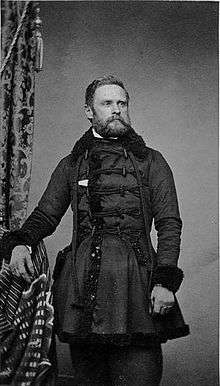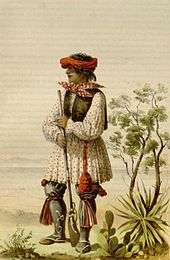Arthur Carl Victor Schott
Arthur Carl Victor Schott (27 February 1814 – 26 July 1875) was a German-American artist, topographical engineer, cartographer, botanist, ethnographer, artist and geologist. The standard author abbreviation A.Schott is used to indicate this person as the author when citing a botanical name.[1]
Arthur Carl Victor Schott | |
|---|---|
 | |
| Born | February 27, 1814 |
| Died | July 26, 1875 (aged 61) Washington, D.C. |
| Occupation | artist, topographical engineer, cartographer, botanist, geologist |
Personal background
Schott was born on 27 February 1814, in Stuttgart, Germany. He was the son of Christian Friedrich Albert Schott. Having finished at a gymnasium and technical school in Stuttgart, Schott worked for a year as apprentice at the Royal Gardens in Stuttgart, after which he enrolled at the Institute of Agriculture at Hohenheim.
Professional background
After the U.S.-Mexican War in which Mexico had to cede almost half of its territory, now known as the American Southwest, it became necessary to survey and map the new, nearly 2,000 miles (3,200 km) of border between the two countries.

In 1851, Schott was approached by the United States Boundary Commission to act as "special scientific collector". He consequently worked as a member of William H. Emory's team in mapping the border separating Texas and the adjacent Mexican territory. Schott contributed more field data to the border maps than any other member of the team, and "became one of the first surveyors of the Rio Grande".[2] He participated in the describing and collecting of botanical, geological, and zoological specimens, also sketching landscapes and members of Indian tribes. Schott also studied the vegetation of Washington, D.C., and for a period worked on the US Coast Survey.
The lithographs and engravings made by Schott in Texas were included in Emory's The United States and Mexican Boundary Survey. Schott produced illustrations of Seminole, Lipan Apache, and Kiowa Indians, also of the Military Plaza in San Antonio, the Mexican military at Piedras Negras and of the Rio Grande. Schott's interests also covered Texas geology in that he analysed sediments and fossils from the Rio Grande basin in an attempt to understand the sea-inundation history of the area. On completion of the border survey, Schott examined the possibility of a ship canal across the Isthmus of Darien, while collecting natural history specimens in Yucatán. In the field of botany he collected specimens of algae and phanerogams from Austria, Colombia, Hungary, Mexico (where he was part of Yucatan's Scientific Commission), and the United States.[3]
Legacy
Schott is commemorated in the scientific names of two North American reptiles: Masticophis schotti and Urosaurus ornatus schottii.[6] He also left many important historical drawings, such as those of the Mexico-US border, the San Antonio Texas Main Plaza, and a complete series of 12 of Yucatán's churches.
References
- IPNI. A.Schott.
- "A Civilian Surveyor on the United States-Mexico Boundary: The Case of Arthur Schott" (PDF). Amphilsoc.org. December 2011. Archived from the original (PDF) on 2012-04-24. Retrieved 2012-07-15.
- "Index of Botanists: Schott, Arthur Carl Victor". Harvard.edu. 2009-05-21. Retrieved 2012-07-15.
- "SCHOTT, ARTHUR CARL VICTOR | The Handbook of Texas Online| Texas State Historical Association (TSHA)". Tshaonline.org. Retrieved 2012-07-15.
- "Arthur C. V. Schott | Smithsonian Institution Archives". Siarchives.si.edu. 2012-01-13. Retrieved 2012-07-15.
- Beolens, Bo; Watkins, Michael; Grayson, Michael (2011). The Eponym Dictionary of Reptiles. Baltimore: Johns Hopkins University Press. xiii + 296 pp. ISBN 978-1-4214-0135-5. ("Schott", p. 237).
Further reading
- Durán-Merk, Alma & Stephan Merk. "Arthur Schott: A True renaissance Man in The Americas". INDIANA 31 (2014): 161-191. Available: http://journals.iai.spk-berlin.de/index.php/indiana/article/view/2043.
- Fontana, Bernard L. (1983). "Drawing the Line between Mexico and the United States". American West, July–August 1983.
- Fox, Gretchen G. (1977). Arthur Schott: German Immigrant Illustrator of the American West. (M.A. thesis, George Washington University, 1977).
- Goetzmann, W.H. (1959). Army Exploration in the American West, 1803–1863. New Haven: Yale University Press. (Second Edition, Lincoln: University of Nebraska Press, 1979).
External links
- Rebert, Paula (2010). "A Civilian Surveyor on the United States-Mexico Boundary: The Case of Arthur Schott". Proc. American Philosophical Soc. 155 (4): 433-462.